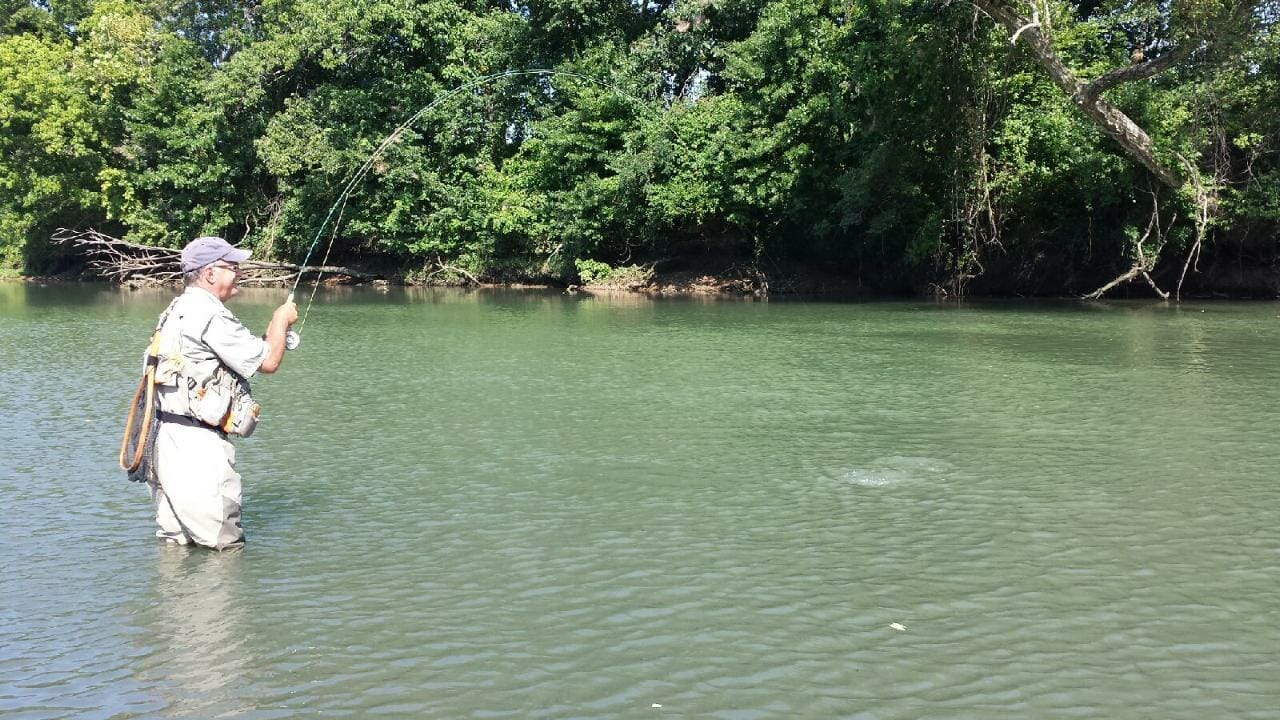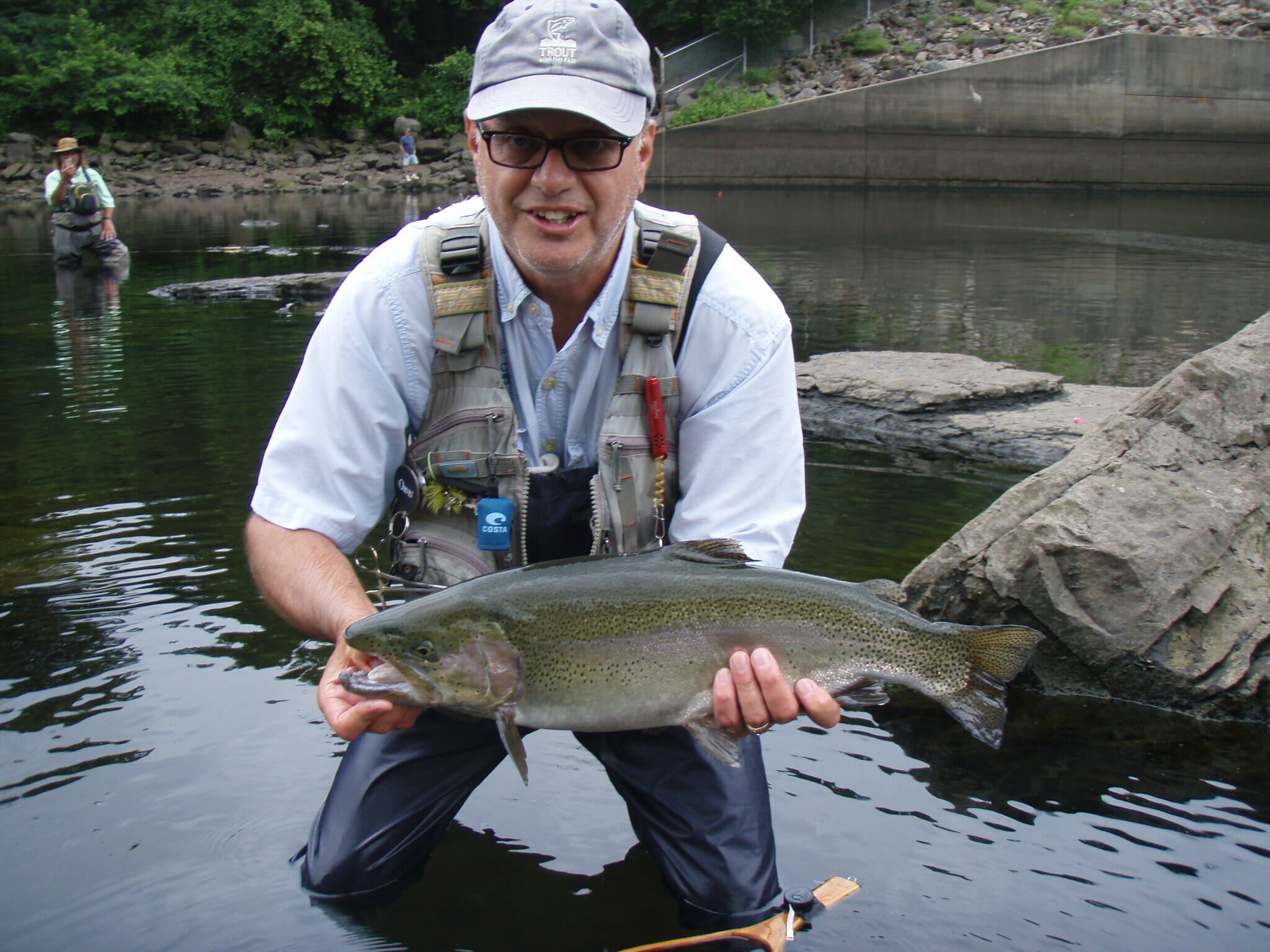TU grassroots leader Scott Hood with a nugget from Oklahoma’s Lower Illinois River.
The Lower Illinois River below Tenkiller Ferry Dam is one of only two streams in Oklahoma with a year-round trout fishery. The Oklahoma Department of Wildlife Conservation (ODWC) manages this tailwater for trout, striped bass and other game fishes thanks to cold-water releases from the dam. ODWC has to rely on water “borrowed” from entities with claims to it to provide these releases.
Earlier this year, the entities with rights to the water in Tenkiller Lake effectively claimed all of it to be reserved for their needs. On August 8 the current 9,000 acre-feet of allocation borrowed by ODWC ran out and flow ceased in the river below the dam between power generation periods. This means that until Tenkiller Lake refills to the “conservation pool” level or a cooperative water sharing arrangement can be constructed, all releases from the dam other than for power generation are now curtailed.
An article in the Tulsa World reported on the advocacy of Trout Unlimited’s Oklahoma Chapter and a Facebook group (Water for the Lower Illinois River) started by TU chapter leader Scott Hood in trying to develop a cooperative water supply solution for the Lower Illinois River that will conserve its trout fishery.
Over the past year Hood participated in meetings with representatives of ODWC, the Army Corps, the Southwest Power Administration, the Oklahoma Water Resources Board and state and federal elected officials to work on the issue. As a shut-off of the borrowed water loomed, in late July Hood worked with TU’s Western Water and Habitat Program and Government Affairs to generate a letter signed by TU’s vice president for government affairs, Steve Moyer, requesting the Corps consider “a range of alternatives to allocate a portion of the conservation pool water for downstream fish and wildlife purposes as authorized in the Congressional authorizing legislation.”
“The Wildlife Department should not have to beg for water on a weekly basis and the Corps and Southwest Power should not have to hold countless meetings to figure out what to do week after week, year after year,” Hood writes in the Tulsa World article. “The bottom line is we need to have a minimum flow to keep the river healthy. That should not be optional.”
In recent years ODWC has not been able to borrow enough water to sustain the cool temperatures and dissolved oxygen levels trout require. Several times the agency has had to suspend planting of trout because water temperatures in the river below the dam became too elevated.

The U.S. Army Corps of Engineers manages the water impounded by Tenkiller Dam. Recreation, fish and wildlife are among the congressionally authorized purposes for Tenkiller Lake. However, as with so many watersheds in the Western U.S., the Lower Illinois’ water supply is over-subscribed—it is fully committed to human purposes (mainly hydropower generation), with little flexibility to be managed to provide enough flows for fish during the summer or in low-water years.
In the past most of the water sustaining the river came from a leak in the dam, which was repaired several years ago. Until last year ODWC was able to borrow 14,500 acre-feet of water for the fishery; this year that was reduced by the municipalities that own it to 9,000 acre-feet, and as of a week ago there is now zero water that can be borrowed for the tailwater.
Having no flow at all between power generation periods could cause a total loss of the Lower Illinois’ trout fishery (even in winter). Local businesses and the regional economy would be injured by such an outcome, as the tailwater is very popular with anglers in a part of the country with few trout streams.
One potential solution to saving the summer trout fishery on the Lower Illinois involves the Army Corps taking a seasonal pool approach where conservation water is stored in the winter and delivered downstream during critical summer periods when both flow quantity and quality historically have been compromised.
Jim Burroughs, streams supervisor for ODWC, said earlier this year in an article by Ed Godfrey in NewsOK, “Let’s say we forget about the trout. There is still state-record quality striped bass [in the Lower Illinois River], stripers over 50 pounds because we have sampled them. There is state-record size walleye there. Without a water source that ODWC has some control over, I don’t see how we can maintain a summertime fishery.”
“If you still have very poor water quality conditions, you are still very likely to have fish kills, even if you don’t have trout there,” Burroughs added. “The issue doesn’t go away even if the trout did.”
What You Can Do
TU will continue to work on a permanent solution for the Lower Illinois River tailwater fishery. You can help by writing to Michael Teague, Oklahoma secretary of Energy and Environment and to J. D. Strong, director of the Oklahoma Department of Wildlife Conservation urging them to continue their work to construct a collaborative solution to the water supply crisis for this excellent trout stream. Since this issue pertains to a dam under federal controls, Oklahoma residents are encouraged to write letters, send emails or make phone calls to Sens. James Inhofe and James Lankford and their Congressional representative asking for their help in developing a permanent solution that will conserve the fishery.
Photos courtesy Scott Hood.



